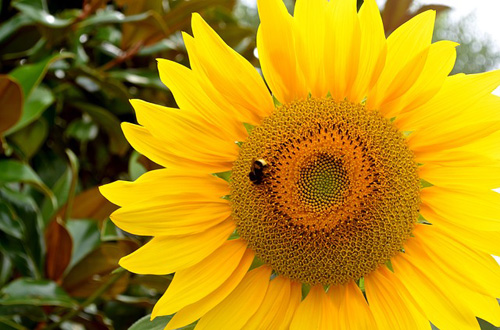
The sunflower (Helianthus annus L.) native to the Americas, arrived in Europe in the 16th century. It is an annual plant that reaches full maturity after about 4 months from sowing. There are two varieties: one with a high content of linoleic acid, the other of oleic acid. The main producing countries are Ukraine, Russia and Argentina. Sunflower oil is extracted by means of solvents. Upon pressing, the seed provides an oil yield of 40-45%. The crude oil extracted is yellow in color. It has a high content of phosphatides and waxes. After the refining and “winterization” process, the oil is bright yellow. It is used as table oil, for frying and for the manufacture of margarines.
The oil, according to current regulations, must meet the requirements indicated in the following data sheet:
| CHARACTERISTICS | REQUIREMENTS | METHOD OF ANALYSIS | |
|---|---|---|---|
| Relative density at 25/20 ° C | from 0.909 to 0.915 | See A.1.1 | |
| Refractive index nD at 25 ° C | from 25°C to 1,467 a 1,471 | See A.1.2 | |
| Number of iodine | from 78 to 90 | SeeA.1.3 | |
| Content in sterols mg / kg | from 1,700 to 5,200 | SeeA.1.5 | |
| Acidity, expressed as oleic acid,% | max 0.5 | See A.1.6 | |
| Number of peroxides, meq oxygen / kg | max 7.0 | SeeA.1.7 | |
| Impurities (petroleum ether)% | max 0.05 | UNI EN ISO 663 | |
| Soaps, expressed as sodium oleate, mg / kg | max 10 | See A.1.8 | |
| Metals, mg / kg (**) | |||
| iron | max 1.5 | UNI EN ISO 8294 | |
| copper | max 0.1 | UNI EN ISO 8294 | |
| lead (1) | max 0.1 | UNI EN ISO 12193 | |
| arsenic | max 0.1 | See A.2.1 | |
| Solvents, mg / kg (***) | |||
| hexane | max 1 | ||
| Caratteri organolettici: | |||
| smell and taste | the oil must not have abnormal or unpleasant odors or flavors | ||
| appearance | clear at 20 ° C | ||
| color | the spectrophotometric absorptions, measured on diluted oil with the same volume of hexane, in a 1 cm tray, with reference to normal hexane, must not exceed the values of 0.20 and 0.10 respectively at 420 and 453 nm | ||
| Permitted additives and relative limits | According to current legislation -2 | ||
| Aromatic polycyclic hydrocardides | According to CE 333/07 and subsequent amendments | ||
| Composition of fatty acids, GLC (capillary),% ISO 5508 | Composition of sterols, GLC (capillary),% See A.1.4 | ||
| CHARACTERISTIC | REQUIREMENTS | CHARACTERISTIC | REQUIREMENTS |
| Myristic acid | ND - 0,1 | Cholesterol | ND – 0.5 |
| Palmitic acid | from 2.6 to 5.0 | Brassicasterolo | ND – 0.2 |
| Palmitoleic acid * | ND – 0.1 | 24-Methylene cholesterol | § |
| Heptadecanoic acid | ND – 0.1 | Campesterol | from 5.0 to 13.0 |
| Heptadecenoic acid | ND – 0.1 | Campestanol | § |
| Stearic acid | from 2.9 to 6.2 | Stigmasterolo | from 4.5 to 13.0 |
| Oleic acid * | from 70.0 to 90.7 | Delta 7 - Campesterol | § |
| Linoleic acid | from 2.1 to 20.0 | Delta 5.23 - Stigmastadienol | § |
| Linolenic acid | ND – 0.3 | Clerosterol | § |
| Arachic acid | from 0.2 to 0.5 | Beta - sitosterol | from 42.0 to 70.0 |
| Eicosenoic acid | from 0.1 to 0.5 | Sitostanol | § |
| Eicosadienoic acid | ND | Delta5 - Avenasterolo | from 1.5 to 6.9 |
| Behenic acid | from 0.5 to 1.6 | Delta 7.9 (0.11) - Stigmastadienol | § |
| Erucic acid | ND – 0.3 | Delta 5.24 - Stigmastadienol | § |
| Docosadienoic acid | ND | Delta 7 - Stigmastenol | from 6.5 to 24.0 |
* Sum of positional isomers which may or may not be separated under the test conditions
** Codex Alimentarius
*** Law Decree n. 64/1993
(1) EC Regulation 466 of 08/03/2001
(2) At the date of publication of this standard, the D.M. n. 209 – 27.2.1996, (Official Gazette no. 96 – 24.4.1996)
§ The components indicated with § and for which no limit value has been set must not be taken into consideration for the purity assessment.
NORMATIVE REQUIREMENTS
ISO 5508 – Animal and Vegetable fats and oils – Analysis by gaschromatografy of methilesthers of fatty acids
ISO 5509 – Animal and Vegetable fats and oils – Preparation of methyl esters of fatty acids
UNI EN ISO 663 – Vegetable and animal oils and fats – Determination of the content of insoluble impurities
UNI EN ISO 8294 – vegetable and animal oils and fats – Determination of the content of copper, iron and nickel. Method for atomic absorption spectrometry with a graphite furnace.
UNI EN ISO 12193 – Vegetable and animal oils and fats – Determination of lead content. Method for atomic absorption spectrometry with a graphite furnace.
APPENDIX (information)
A BIBLIOGRAPHY
A.1 NGD REFERENCE METHODS (GRASS STANDARDS AND DERIVATIVES)
A.1.1 NGD C18- Determination of the relative density
A.1.2 NGD C31 – Determination of the refractive index
A.1.3 NGD C32- Determination of the iodine number according to Wijs
A.1.4 NGD C71 – Determination of sterol composition by capillary column gas chromatography
A.1.5 NGD C72 – Determination of sterol content by capillary column gas chromatography
A.1.6 NGD C10 – Determination of acidity
A.1.7 NGD C35 – Determination of the number of peroxides
A.1.8 NGD C8 – Determination of soaps
A.2 OTHER REFERENCE METHODS
A.2.1 AOAC 963.21 – 1990 Arsenic in food. Kjeldahl Flask Digestion. Final action.
AOAC 952.13- 1990 Arsenic in food. Silver Diethyldithiocarbamate method. Final action.


